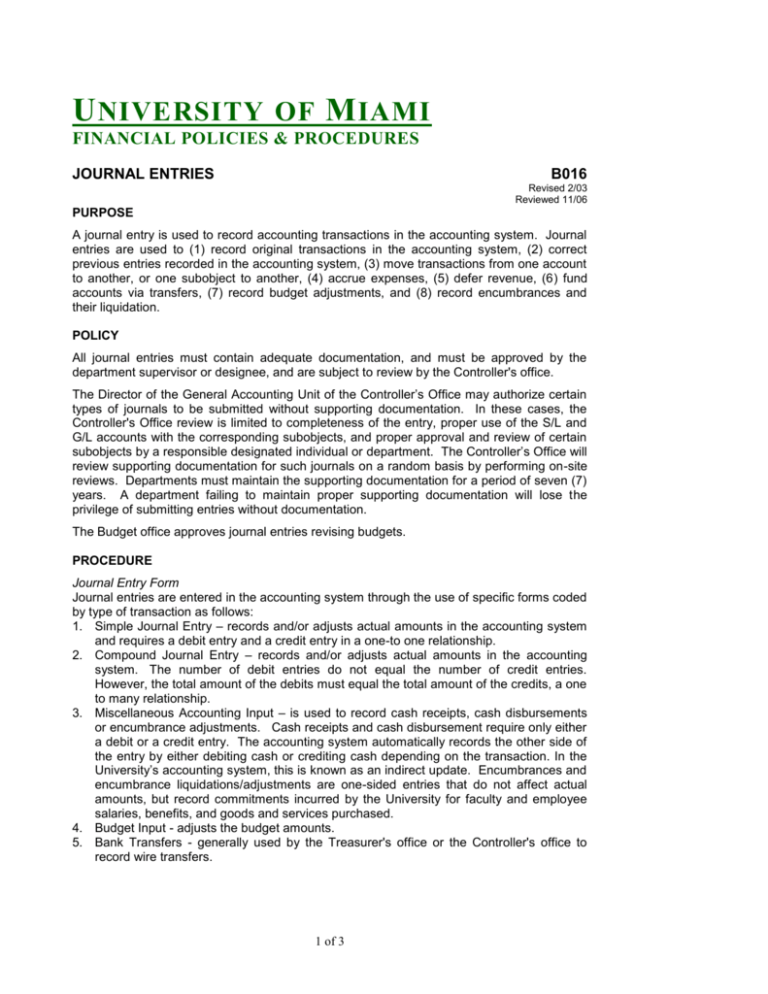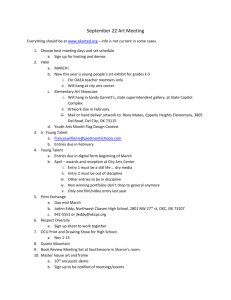GENERAL JOURNALS B025
advertisement

U NIVERSITY OF M IAMI FINANCIAL POLICIES & PROCEDURES JOURNAL ENTRIES B016 Revised 2/03 Reviewed 11/06 PURPOSE A journal entry is used to record accounting transactions in the accounting system. Journal entries are used to (1) record original transactions in the accounting system, (2) correct previous entries recorded in the accounting system, (3) move transactions from one account to another, or one subobject to another, (4) accrue expenses, (5) defer revenue, (6) fund accounts via transfers, (7) record budget adjustments, and (8) record encumbrances and their liquidation. POLICY All journal entries must contain adequate documentation, and must be approved by the department supervisor or designee, and are subject to review by the Controller's office. The Director of the General Accounting Unit of the Controller’s Office may authorize certain types of journals to be submitted without supporting documentation. In these cases, the Controller's Office review is limited to completeness of the entry, proper use of the S/L and G/L accounts with the corresponding subobjects, and proper approval and review of certain subobjects by a responsible designated individual or department. The Controller’s Office will review supporting documentation for such journals on a random basis by performing on-site reviews. Departments must maintain the supporting documentation for a period of seven (7) years. A department failing to maintain proper supporting documentation will lose the privilege of submitting entries without documentation. The Budget office approves journal entries revising budgets. PROCEDURE Journal Entry Form Journal entries are entered in the accounting system through the use of specific forms coded by type of transaction as follows: 1. Simple Journal Entry – records and/or adjusts actual amounts in the accounting system and requires a debit entry and a credit entry in a one-to one relationship. 2. Compound Journal Entry – records and/or adjusts actual amounts in the accounting system. The number of debit entries do not equal the number of credit entries. However, the total amount of the debits must equal the total amount of the credits, a one to many relationship. 3. Miscellaneous Accounting Input – is used to record cash receipts, cash disbursements or encumbrance adjustments. Cash receipts and cash disbursement require only either a debit or a credit entry. The accounting system automatically records the other side of the entry by either debiting cash or crediting cash depending on the transaction. In the University’s accounting system, this is known as an indirect update. Encumbrances and encumbrance liquidations/adjustments are one-sided entries that do not affect actual amounts, but record commitments incurred by the University for faculty and employee salaries, benefits, and goods and services purchased. 4. Budget Input - adjusts the budget amounts. 5. Bank Transfers - generally used by the Treasurer's office or the Controller's office to record wire transfers. 1 of 3 Accounting Transaction Coding Document reference fields differ from one type of journal to another, i.e., check #, BERF #, check requisition #, Purchase Order #, etc. Please contact the General Accounting unit of the Controller’s Office for explanations on how these fields are used or attend a Financial Record System (FRS) training session. Information on available training sessions and registrations is available at the Professional Development and Training website: http://www.miami.edu/UMH/CDA/UMH_Main/1,1770,2421-1,00.html. Supporting Documentation All journal entries together with adequate supporting documentation must be submitted and retained in the Controller's office. The only exceptions are those departments authorized by the Director of General Accounting to retain the supporting documentation, or those journal entries that enter the accounting system through a subsystem as specified in Appendix A at the end of this policy. The journal and its supporting documentation constitute the University's official record of a transaction and must contain sufficient description or explanation to adequately describe the transaction to an auditor or other outside party. Format Journal entries should be submitted in the proper format, as follows: 1. Use a standard form (size 8-1/2X14) provided by Materials Management or a computer reproduction. 2. Using an adding machine, add the amounts of the entries and produce a hash total. Staple the adding machine tape to the right hand side of the original journal. If the form used is a computer form, ensure that the hash total includes all the rows of the journal entry. 3. Staple back-up documentation for the entries behind the journal form. 4. Each journal submitted to the Controller's Office must balance (debits equal to credits). 5. Journals must be approved by department heads or other authorized personnel before forwarding to the Controller's office for input or storage. 6. Journals are to be prepared in BLACK or BLUE ink. Whiteout and erasures should not be used. When an incorrect entry or amount is entered, it should be crossed out, initialed and entered in the following line. 7. All journals must be accompanied by a Batch Control Form (see below). Blank copies can be obtained from the Controller’s web page at http://www.miami.edu/controller and click on Forms. Batch Control Form The batch control form requires the insertion of a unique batch identification number and data totals to assist in the verification of the data entry function. The batch identification consists of six alphanumeric characters which identify the individual or the subsystem originating the transaction. The data totals consist of a batch total count representing the number of accounting transactions in the batch and a hash total on the dollar amounts from the accounting transactions. The originator of the batch is responsible for filling in the batch identification, the batch count total, a short description of the entry, and the hash total. The Controller's Office is responsible for completing the data entry portions of the form to identify the data entry person, the date entered in the accounting system, and time completed, and to verify the system batch total amount and count to the manual information entered by the originator. The Medical Finance Office performs a similar verification function as it inputs Medical School entries. 2 of 3 APPENDIX A Subsystems that Send Information Via Online Journal Entries to the Accounting System Batch id Description Department ALU APD APC APP APV ARS AW BCF BDG BIL BIO COP CRCDWB CTX DEG DPO DUP DUR ENC008 ENC009 GAO IT LD MU OCR OHD PBD PBR POS PPC PPM PPR PR CBA PR001 PR002, 003 PR005, 006 PR020 PR030 PUB418 PUR PWO PWOB SPM UT Xxx Alumni Accounts Payable – charges (debits) Accounts Payable – credits Accounts Payable EDI- charges (debits) Accounts Payable-EDI- credits Accounts Receivable– Students & Other Away Tuition – Medical School Overhead (Indirect Cost) Encumbrances Budget Roll Computer Billing Biomedical Engineering Billing Copy Center Billing Credit Card Web Telecommunications Billing DEGA–Check Req./Reimbursements Departmental Purchasing Duplicating Charges Gift System Processing Environmental Serv. Encumbrances Computer Billing Encumbrances Bank Transfers IDX TAX – Medical School Labor Distribution – Payroll UMHC Open Commitment Year End Reversals Overhead (indirect cost) Purchase Orders (Commitments) Encumbrance Correction Postage Physical Plant- Gables Physical Plant – Medical Physical Plant – RSMAS Sponsored Cash Basis Clearing (Pharmaceutical Accounts) Student Activity Fee Sponsored Programs Receivable Endowment - splits funds between unrestricted and permanent Monthly recurring Journal Entries (rent, cost share, med malpractice and bonds) Monthly recurring Journal Entries - ABLEH Purchase order requisitions Purchase Orders (Commitments) Work Order – Buildings Work Orders – Buildings Medical Budgets Medical Dean’s Tax IDX Patient Receivables 3 of 3 Alumni Office Accounts Payable Accounts Payable Accounts Payable Accounts Payable Student Account Services Medical Finance Controller’s Office-Sponsored Programs Budget Office Information Technology Biomedical Engineering Copy Center Information Technology – Joe Abreu Telecommunication Disbursements Purchasing Duplicating Development Facilities Administration Information Technology Restricted to Controller’s & Treasurer’s Medical Finance Payroll UMHC Controller’s Controller’s (Sponsored Prog.) Purchasing Purchasing Mail Systems Facilities Facilities Facilities Controller’s (Sponsored Programs) General Acctng. (Controller’s) Controller’s Restricted to Controller’s & Treasurer’s Controller’s Controller’s Publications Purchasing Facilities & Physical Plant Facilities Sponsored Programs Controller’s UMMG Administration







